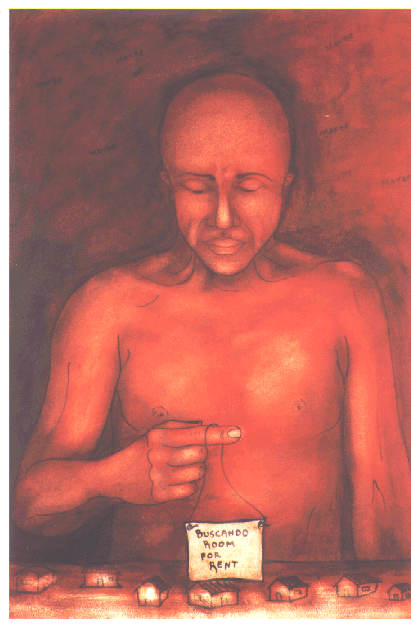|
Dreaming of Home |
|
Above and below, paintings © 2002
Ricardo Cartagena, from “The Eviction Chronicles” |
|
Two years ago, the artist Ricardo Cartagena was sharing an apartment in San Francisco’s Mission District with enough space to sleep and work. “I always live where I paint,” he explains. “I sleep over my art.” One day, he painted what he calls “a premonition.” “I painted a man sleeping on the street with a blanket, a newspaper and a shopping cart,” he says. A month later, Cartagena was evicted. His name hadn’t been on the lease of the apartment that he shared with the friend, who was moving out. The owner wanted more rent, but Cartagena was unable to do his usual work as a handyman because he had hurt his shoulder in an accident. The owner ignored his pleas for more time to recuperate, and took him to court when he refused to move. “It was like dominoes,” Cartagena recalls. “One thing happened after another.” Soon, Cartagena was bouncing between family and friends – and even a storage facility. The owner of his mother’s building warned her against having too many “visitors” in her apartment – Cartagena has four brothers – because of the drain on the building’s utilities. He couldn’t stay long with friends, either. “Everyone was scared about being evicted,” he says. In desperation, he rented a storage facility, where he slept and painted until the manager found out and evicted him. Now he’s renting a garage for $300 in a neighborhood with a lot of drugs and gangs, he says. Every day he goes to bathe at a different friend’s apartment. But the inconvenience doesn’t bother him. “I can paint freely,” he explains. “At night, everyone is sleeping, but I’m painting.” Cartagena (also known as Cachi) is only 40 years old, but he has already lived enough for two lives. He was a political prisoner in El Salvador, where he was associated with the Farabundo Marti Liberacion Nacional, a revolutionary party. He fled the country after the war and, in 1992, joined his mother and four brothers, who had settled in San Francisco seven years earlier. His paintings then reflected what he had experienced in El Salvador. “I was painting about the torture of the innocents,” he says, and describes a painting by that name with angels that have been mutilated, without hair or limbs. |

Now, many of his paintings reflect his experience with eviction, homelessness and discrimination. His work was featured recently in “The Eviction Chronicles,” an exhibit of art and photography at the Focus Gallery in San Francisco that also included the work of photographer Gary Stenger. Cartagena’s paintings have a haunting, dreamlike quality. In one painting, a man wears a white mask, representing the white friends who help people of color rent an apartment. In “Room for Rent,” the word “maybe” emerges repeatedly from the background, a visual Greek chorus, behind a man holding a “room for rent” sign. “The first night I slept with friends, they told me to look for a room,” Cartagena says. He did, and the response was the same: “Everyone told me ‘Maybe, maybe, maybe.’” In his paintings, houses are small, reflecting what he sees in his community, where “houses are too small for the people.” Cartagena has seen a lot of changes in his 10 years in the Mission District, not all of them bad. “The Latino community is more organized,” he says. The collapse of the dotcom economy has slowed the gentrification of the Mission District, at least for now (see Shelterforce #124). Cartagena says he sees more “for rent” signs in San Francisco, but prices are still high and landlords demand a hefty security deposit. He’s still looking for a place to live and paint.
|







Comments